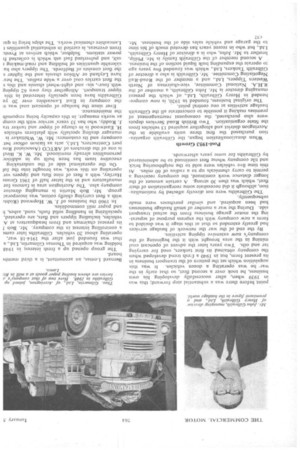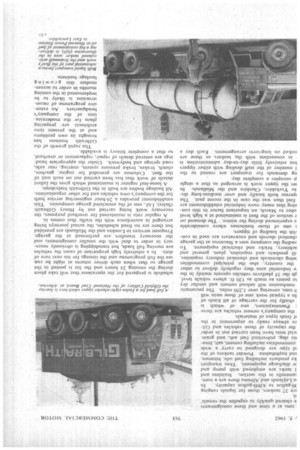IZESIGI-IT BROUGHT SUCCESS EAST LANCS HAULIERS
Page 69

Page 70

Page 71

If you've noticed an error in this article please click here to report it so we can fix it.
pers, Tankers and Lorries of the braith Organization Provide a Varied Service to Local Industry
By Ashley Taylor, A.M.I.R.T.E., Assoc.Inst.T.
Ik/NlY changes have taken place since the late Mr. Ienry Gilbraith purchased the Greyhound Garage t Accrington in 1920. Seeing possibilities in ng the haulage business locally he converted an abanc into a goods vehicle in 1924, thus laying the ons of a business that now employs a fleet of over s. These cover over three million miles annually, are than 500,000 tons of goods and consume over gallons of fuel oil in the process, lition to platform lorries, tippers and conventiona the fleet now includes pneumatic discharge bulk and the range of commodities carried includes fuel id construction materials, sand, cement, bricks, s, chemicals, heavy machinery, cotton and agricul)(Ince. Apart from the group's haulage interests, soeiated companies operate a chain of service and garages.
-ory, in fact, is one of a business growing in conseof foresight. Like his father before him, the Mr. Henry Gilbraith had served an engineering ceship and when he entered the motor business he
the automobile engineering required by the local and the brickworks.
,tered haulage, as we have said, in 1924, and the of goods licensing saw Mr. Gilbraith with four of nal A licences. But it was 15 years from his starting point before there was a substantial step forward; this was in 1939 when, after successfully developing his own business, he took over a second fleet, so that early in the war he was operating a dozen vehicles. It was this acquisition which set the pattern of the transport business in its present form, but in 1940 a fresh trend developed when the company obtained its first tankers, used for carrying tar and oils. Two years later the advent of opencast coal mining in the area brought with it the beginning of the company's now extensive tipping activities.
By the end of the war the network of haulage services had greatly extended so that at this stage it was decided to form a new company with the express purpose of separating the motor garage business from the actual transport side. During the war a number of small haulage businesses had been acquired, and similar purchases were made subsequently.
The Gilbraiths were not directly affected by nationalization, although it did necessitate some reorganization of their fleet, which was then 30 strong. A certain amount of the longer distance work continued, the company receiving a permit to carry chemicals up to a radius of 60 miles. At this time five vehicles were sold to the neighbouring brick and tile company whose fleet continued to be administered by Gilbraiths for some years afterwards.
Post-1953 Growth
When denationalization began, the Gilbraith organization purchased the first three units available in the Accrington district and altogether acquired 13 vehicles from the State organization. Two British Road Services depots were also purchased, the consequent rearrangement of premises making it possible to concentrate all the Gilbraith haulage activities at one central point. , The original business, founded in 1920, is now comprehended in Henry Gilbraith, Ltd., of which the present managing director is Mr. John Gilbraith, a member of the R.H.A. National Committee, vice-chairman of North Western Tippers, Ltd., and a member of the Road-Rail Negotiating Committee. Mr. Gilbraith is also a director of Gilbraith Tankers, Ltd., which was founded five years ago to operate the expanding bulk liquid section of the business.
A second member of the Gilbraith family is Mr. Philip, brother to Mr. John, who is a director. of Henry Gilbraith, Ltd., but who in recent years has devoted much of his time to the garage and vehicle sales side of the business. Mr.
c32 Bernard Lomas, an accountant, is a third mernbe board.
The group opened up a fresh interest in 1948 holding was acquired in Thomas Gilmartin, Ltd., a that was founded just after the 1914-18. war, operating about 20 vehicles. Gilbraiths later came a controlling interest in the company. Mr. Bob / its present chairman and from headquarters at A vehicles, including tippers and flats, are operated, specializing in handling solid fuels, sand, ashes, h and paper mill commodities.
In 1960 the business of J. W. Hopwood (Risht( with a fleet carrying chiefly cotton, was incorporat group. Mr. Bob Martin is managing director company also. The Accrington area is famous for manufacture and in the latter half of 1961 Gruns Hartley, with a fleet of nine flats and tippers ver operating on this work, was brought into the to] On the operational side of the undertaking executive team has been built up in additior personalities already mentioned. Mr. W. K. Bird is one of the directors of ARTCO (Associated Roa port Contractors, Ltd.), acts as liaison officer bet company and its customers: Mr. W. Whittaker is manager dealing specially with platform vehicles H. Eastwood is in charge of tipper and tanker tra J. Ruddy, who has 33 years' service with the comp as works manager, in this capacity being responsib the maintenance.
Ever since the haulage of opencast coal was sl the company in East Lancashire over 20 ye Gilbraiths have been specially interested in this tipper transport. Altogether they own 62 tipping with four-, sixand eight-wheel chassis and this s the fleet carries coal over a.wide radius. The hea: have Leyland or Albion chassis and the lighter s the fleet consists of Bedfords. The tippers also ha siderable quantities of building and road-making salt, and pulverized fuel ash which is collected fr power stations. Sulphur, which arrives at Prestc from overseas, is carried in substantial quantities t Lancashire chemical works. The ships bring in quz tons at a time and these consignments • e cleared quickly to expedite the vessels' d.
ire 27 tankers, those for liquids ranging )0-gallon to 4,000-gallon capacity. In o Leylands and Albions there are a num ;ammells in this section. Stainless and 1 tanks are employed with pump and
3r discharge equipment. They transport
ke products including fuel oils, bitumen, Ind naphthalene. Powder tankers of the d type are designed to carry• a wide commodities including cement, salt, limesic slag, pulverized fuel ash, and grain.
cial tests have been carried out in order the capacity of these vehicles and Gilre always ready to experiment in the g fresh types of materials.
the company's newest vehicles are three
Pneutnajectors, one of which is chiefly for the carriage of all kinds of In .a typical week one of these units will . CI tons, covering over 1,250 miles. The pneumatic mechanism will unload cement and similar dry to points as much as 120 ft. above vehicle level. gh the 35 platform vehicles operate mainly in the .e industrial area they regularly deliver to other the country, also the principal commodities )eing chemicals and chemical industry requisites, ill products and requisites, plant, general and achinery, bricks and electrical equipment. To aading the company uses a Stacatruc at the garage chanical shovels and excavators are used in coniith the loading of tippers.
; one of those businesses where considerable s experienced during the winter. The demand on r section of the fleet is maintained at a high level ober to March, an important factor in this coneing that many more industrial establishments are fuel than was the case in the recent past. The )perate both locally and over medium-long disto Yorkshire, Cheshire and the Midlands. In ;es the tipper work is arranged so that a single p occupies a complete day.
ng demands for transport are routed to the 1 member of the staff dealing with either tippers but relatively little day-to-day administration is in connection with the tankers as these are ooked on long-term arrangements. Each day a
schedule is prepared -for the operations-that will take place during the ensuing 24 hours and the list is posted in the
garage so that when each driver returns at night he can see the full programme and the timings for his next turn of duty. In a relatively high proportion of cases the vehicles are moving full loads, but transhipping is obviously necessary in order to deal with the smaller consignments and the necessary transfers are performed at the garage. Frequent services to London and the Midlands are provided but there are no fixed schedules, the actual journeys being arranged in accordance with the traffic that comes in.
A regular rota is maintained for overhaul purposes, the necessary work being carried out by Henry Gilbraith (Sales), Ltd., one of the associated garage companies. This establishment provides a 24-hour engineering service both for the company's own vehicles and for other organizations. All haulage bodies are built in the Gilbraith bodyshops.
A loose-leaf register is maintained which gives the fullest details of work that has been carried out on each unit of the fleet. Columns are provided for engine, gearbox, clutch, brakes, brake pressure system, steering, rear axle, road springs and bodywork. Under the appropriate headings are entered details of repair, replacement or overhaul, so that a complete history is available.
The rapid growth of the Gilbraith business has brought its own problems and at the present time architects are preparing plans for the modernization of the company's headquarters. An extensive programme of reconstruction is likely to be implemented in the coming months in order to accommodate this growing haulage business.




























































































































